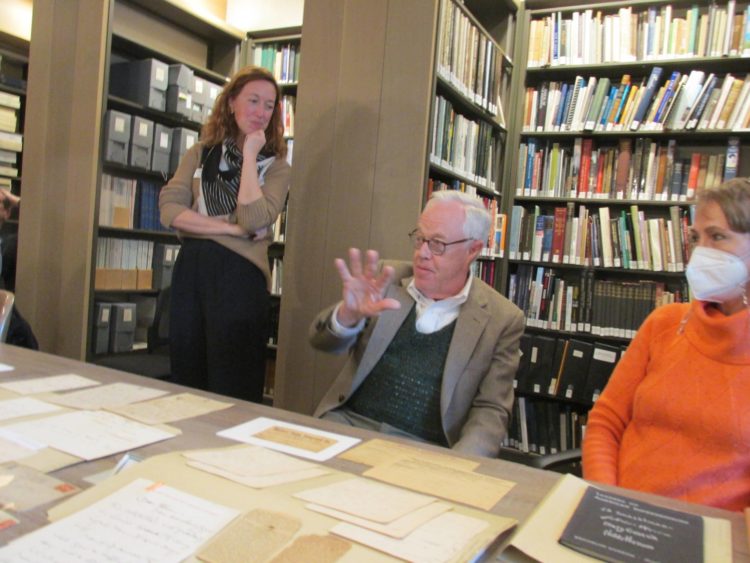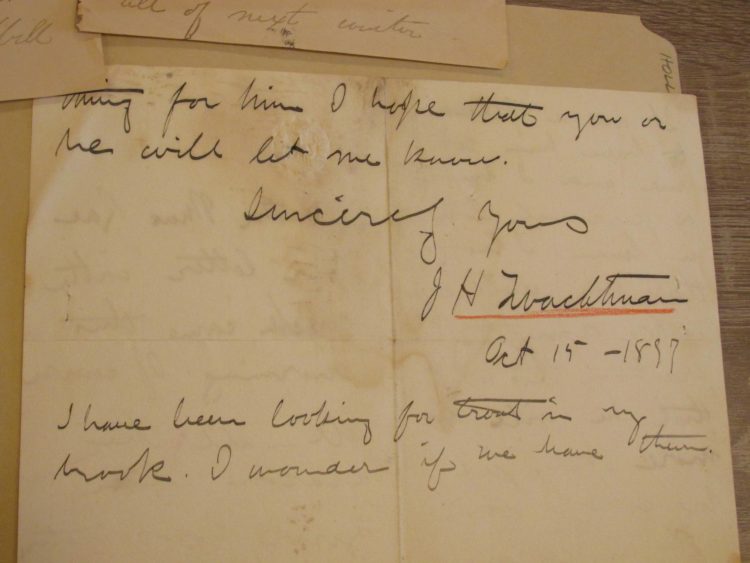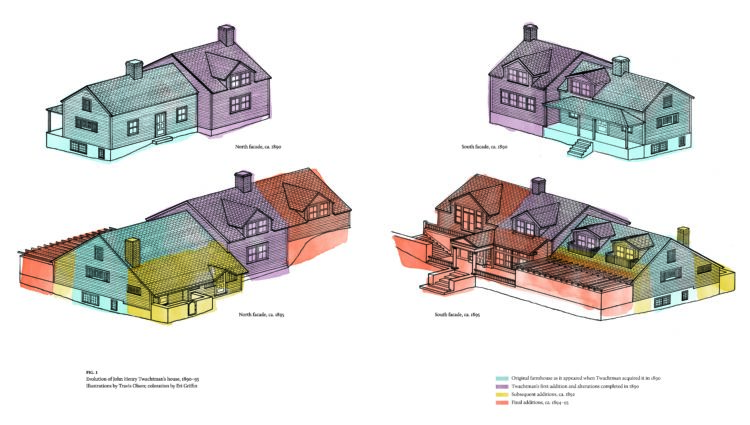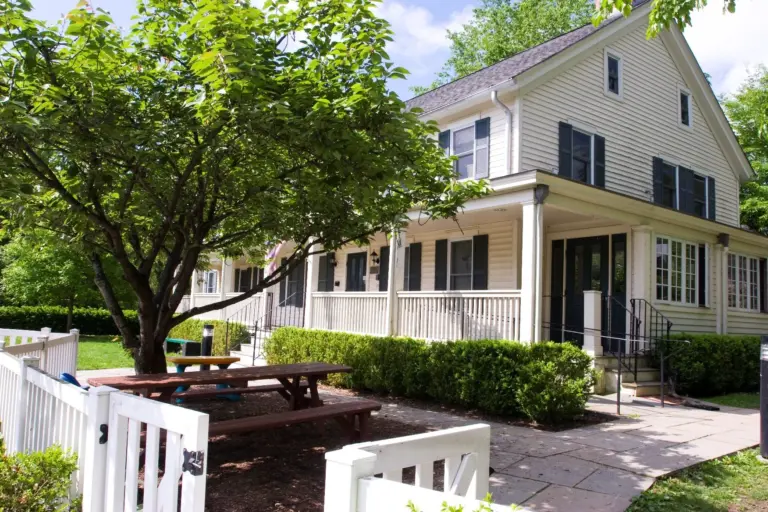Bringing John Henry Twachtman Alive in a visit to the Historical Society Archives
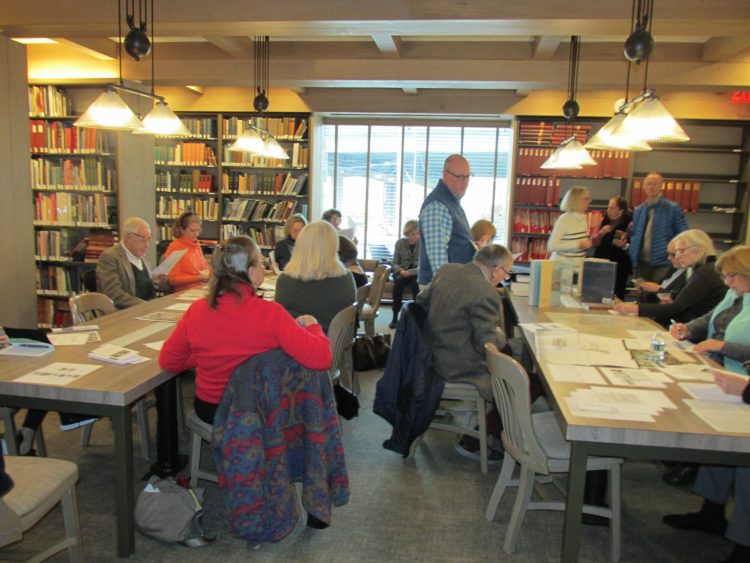
By Anne W. Semmes
Last Sunday afternoon the Greenwich Historical Society (GHS) opened the door to its James Stevenson & Josie Merck Stevenson Library & Archives for the first time in over a year to the thirty and more members and nonmembers wishing to get up close and personal with the life and times of American Impressionist painter John Henry Twachtman, whose work has been on exhibit since October of last year, ending on January 22.
Archives Curator Christopher Shields welcomed the crowd gathered around the library tables with how pleased he was that after the damaging floods of Hurricane Ida had closed down the GHS site and pushed the planned Twachtman show forward, “We’re back, and we’re better than ever. We’ve made some really important changes. So, it’s nice to have a group in here.”
Found displayed on one of the library tables were letters from Twachtman written days before he died suddenly in July of 1902 at age 49. “It’s recorded that he had a brain aneurysm,” shared Maggie Dimock, curator of the Society’s exhibitions and collections. “He was in Gloucester, Massachusetts on a painting trip when he died,” she added. She cited those letters were addressed to Josephine Holley, owner with her husband Edward of the Holley House boarding house in Cos Cob that became the base for a summer school for the artist colony where Twachtman taught.
“Our collection here,” noted Dimock, “is probably the core collection of what we know about the relationship, or what anyone knows about the relationship, between Twachtman and the Holleys, and really kind of the day-to-day workings of this boarding house, but also that Cos Cob art colony.”
“Twachtman’s wife and his family and his children were overseas,” Dimock shared of the time of those last letters. “They were in France because their oldest son, J. Alden, had a painting scholarship through Yale where he, for two years, was able to study abroad. And so, he was studying in Paris. And so, essentially, Twachtman was kind of living his own life.
“Their beautiful house that they loved so much on Round Hill Road was being rented out to boarders, and so he was periodically lodging with the Holleys. But then, when he wasn’t here in Cos Cob, he was often in the city because he had a teaching job at the Art Students’ League.”
And there on the library table were letters from where he stayed in New York at the Player’s Club where he was a member. “The other members included people like Stanford White [a friend of Twachtman’s] It was very much the kind of society, sort of artistically inclined, culturally inclined, social milieu of New York at this time, around the turn of the century.
“But a lot of what he’s doing is writing to say, ‘I can’t get any work done here because it’s too busy. I miss being in Cos Cob. I wish I was back there in that beautiful house.’”
Twachtman was referring to his Round Hill Road house that he spent years enlarging with his growing family as shown in the illustrations in the Twachtman exhibit upstairs in the gallery. Those illustrations of that growing house came about, shared Dimock, with input from “a great group from Charles Hilton Architects who did a full set of measured drawings,” and help from GHS trustee Davidde Strackbein, present as an attendee. “But then, of course,” added Dimock. “John Nelson [present] who I hope doesn’t mind me calling him out as the fellow who currently resides at that same house, and who is probably like a primary experiential archeologist of its history.”
“I pay the bills,” quipped Nelson with a grin.
“And he [Nelson] does these great shows [at the house], said an attendee, “with the copies of the paintings on the specific parts of the property. What, 40 or 50 painting transparencies?”
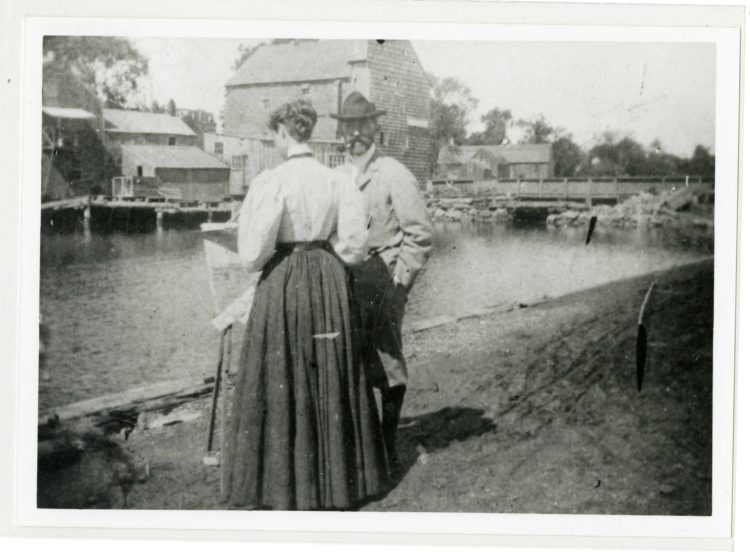
“They’re reproductions.” said Nelson. “When they were making the catalog, they digitized a lot of the Twachtman art, and Maggie has made high-resolution images that are now on that 46-painting tour, and they’re mounted right where Twachtman painted them.”
“I don’t mean to put you on the spot, John,” said another attendee. “But what is it like to live in Twachtman’s house?” [Nelson is beginning his 51st year living there.]
“What really gets me,” he answered, “is I think Twachtman just had a profound love of nature. And I have felt that…this house brings nature in and the house out…The portico, when you sit under the portico and your girlfriend’s beating you at gin rummy or something, you’re looking for an excuse to go inside because it’s starting to rain, but you don’t feel the rain. You’re under the portico…But the whole strength of the house is brought to ground right there, literally. And you’re part of it, but you’re still outside. And the way it reflects the moonlight is just magic.”
The conversation in the library then moved off to Twachtman’s German heritage, and his rough start, marrying above himself the daughter of a banker, and then having to prove himself, “taking over a cattle ranch in Canada…and miserable,” to painting cyclorama projects, before finally getting “his foot in that New York art world.”
Guests were then invited to “to take a peep at some of the back corners of the archives” in its vault storage area, as did attending Bea Crumbine. “It is always a pleasure to visit the vault,” she shared. “Maggie Dimock presented excellent explanations of the art being protected within that area. It is easy to understand how these Greenwich treasures can inspire visitors to ask and answer questions about local history.”
For attendee Ross Ogden – noted Red Cross volunteer, it was John Nelson’s comments about Twachtman’s former home on Round Hill Road that had helped him appreciate “how important natural surroundings were to him and how they influenced his painting.” He hoped the Greenwich Historical Society would hold similar events in the future. “They give great background and context for the exhibits.”
Fellow attendee David Brownwood agreed. “The presentation by Christopher and Maggie of the material about Twachtman, his family, his friends and his Greenwich house underscored the critical preservation role of the Historical Society. The original letters bring Twachtman and his family to life. Remarkable!”
The exhibition, “Life and Art, The Greenwich Paintings of John Henry Twachtman” will be on view at the Greenwich Historical Society through January 22.
